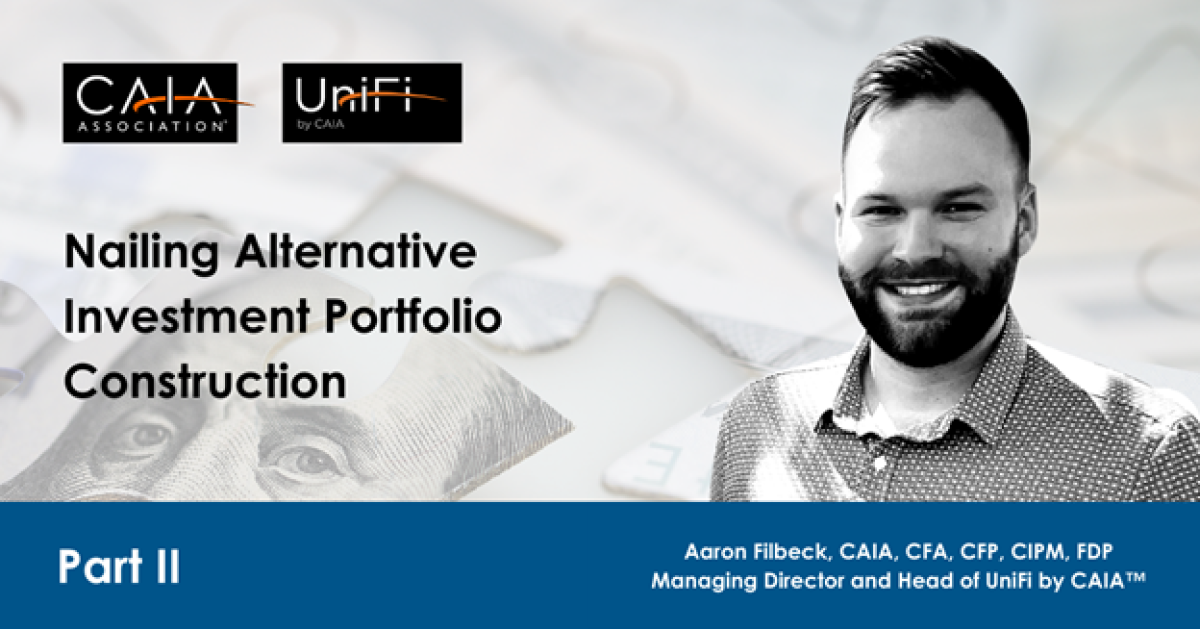By Aaron Filbeck, CAIA, CFA, CFP®, CIPM, FDP, Managing Director, Head of UniFi by CAIA™ at CAIA Association
The analogy of building a house is not too far off from constructing a diversified portfolio. If asset allocation is like deciding the location of your new home, there are many more steps to take before your portfolio is move-in ready. In Part I of this three-part series from Aaron Filbeck, CAIA, CFA, CFP®, CIPM, FDP, Managing Director, Head of UniFi by CAIA™ at CAIA Association, he walked through some basic frameworks for advisors approaching portfolio construction with alternative investments. Here, in Part II, he delves into what next steps define all that is available to clients after the investment philosophy has been determined through the investment policy statement and policy portfolio.
Once the investment philosophy has been determined through the investment policy statement and policy portfolio, it’s very important for the advisor to make sure they know what is available to their clients. Much of this decision rests on two things:
- Ability to access investment strategies
- Tolerance for illiquidity
The opportunity set for a qualified purchaser (QP) is different than that of an accredited investor (AI). Since QPs are required to have portfolios of more than $5 million in assets, their opportunity set is much larger and they can access more standard fund structures, such as a limited partnership structure. AI investors are slightly more limited in what they can access since they are only required to have a net worth of $1 million.
Regardless of regulatory concerns, some portfolios are too small to warrant an allocation to traditional limited partnership structures due to their minimums. For example, some private equity funds may have minimum investments of $100,000 while others may require several million dollars. It may not be suitable for a QP investor with only $6 million in investible assets to allocate to funds with high minimums, even if they qualify in the eyes of the SEC.
Fortunately, democratization has led the way to access alternative investments in different types of investment vehicles with varying liquidity profiles, including the as shown in Exhibit 2:
Exhibit 2: Liquidity Spectrum of Fund Vehicles

Source: Author’s illustrations
While not all vehicles are prudent for illiquid and/or long-term focused strategies, some offer the best of both worlds.
From a portfolio construction perspective, there are three levels of liquidity that an advisor must consider when allocating to alternative investments:
- Client Liquidity Tolerance – how much is the client willing and able to lock up and for how long? Ideally, this thought exercise should be evaluated under a stress test scenario. It is easy to say a client can handle illiquidity when times are good. What will the liquidity need look like after a market drawdown, or major life event? Don’t forget, 20% portfolio illiquidity can jump to 40%+ illiquidity in a matter of days or weeks (see 2008 or 2020) and withdrawals serve to exacerbate that dynamic.
- Vehicle Liquidity Allowance – what are the liquidity parameters for the fund vehicle (daily, monthly, quarterly, annually, etc.)?
- Strategy Liquidity Profile – what does the strategy require in terms of liquidity, either by the assets it holds, or the strategy being pursued?
This process is like a funnel, in that the universe gets smaller with each constraint.
Exhibit 3: Three Levels of Liquidity

Source: Author’s illustration
These three levels of liquidity are sequential. As each level is determined, it sets the opportunity set available for the next. For example, a client with a high tolerance for illiquidity can effectively invest in any vehicle, which gives them wider access to alternative investment strategies. Alternatively, a client with a low tolerance for illiquidity may need to focus their efforts on more liquid wrappers, such as open-end mutual funds or interval funds.
In Part III of Nailing Alternative Investment Portfolio Construction, we’ll pick up once the policy portfolio has been constructed and the liquidity profile has been explored. At that point, the investment opportunities should reveal themselves. The art of portfolio construction can now begin!
About the Author:
Aaron Filbeck, CAIA, CFA, CFP®, CIPM, FDP is managing director and head of UniFi by CAIA™ at CAIA Association. He earned a BS with distinction in Finance and a Master of Finance from Penn State University. Contact him at afilbeck@caia.org.





